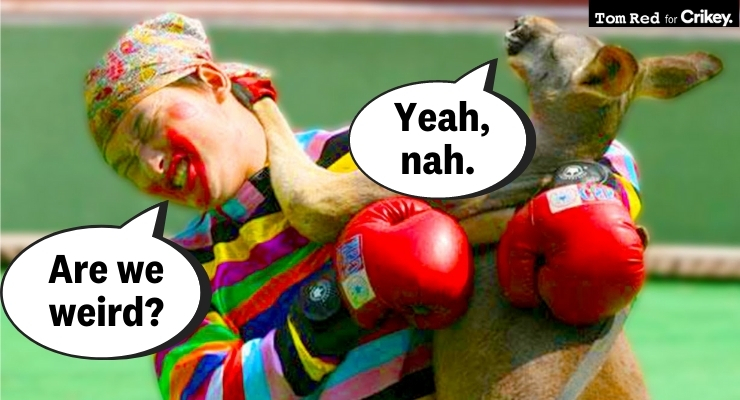
The internet’s globalisation of content has trumped the tyranny of distance and offered Australia the gift sought by Scottish poet Robert Burns: to see ourselves as others see us.
As a handful of large media corporations seek to build worldwide audiences, they’ve looked to Australia for enlarged bureaus (like The New York Times or BBC) or localised franchises (like England’s Guardian or, briefly, BuzzFeed).
Now these experiences are being turned into that rarest of things: books about Australia by non-Australians, with the more clear-eyed view of the outsider. The latest comes from The New York Times‘ Australian bureau chief Damien Cave. It’s perhaps less a book about Australia than it is about the process of Cave and his family becoming Australian — sort of They’re a Weird Mob for a modern country.
The donkey that carries Cave’s story, Into the Rip, is the Bronte Surf Life Saving Club, which Cave joins first as a parent of two Nipper-aged children and then as a seeker for the bronze medallion. His journey is crafted as a meditation on risk, both physical and social. (Indeed, the second part of Into the Rip‘s title reads: How the Australian Way of Risk Made My Family Stronger, Happier … and Less American.)
Cave writes: “To become a lifesaver — to get better at risk, especially as an American — I needed to fully let go of my independence and ego. I needed to suppress all the idealised I’ve-got-this-don’t-tread-on-me individualism that I’d been surrounded by in the US and grow towards a different worldview that put connection (not self) at the centre of everything.”
Lifesaving acts as a metaphor for what Cave perceives as the Australian balance: “There’s a lot that the Australians I’ve met … tend to overlook. For one thing, they underestimate the value of Australia’s approach to risk management in life’s most consequential areas … where policy and behavioural norms have found an equilibrium between recklessness and over-protection.”
For Australians deep in COVID’s lockdown-mockdown wars, “equilibrium” seems generous. But with one eye cocked to the US experience, Cave perhaps sees better what have been in truth minor variations on a common theme. Australia’s “middle path through pandemic risk” built on collective commitment made the COVID experience different, says Cave, “because, I came to understand, its approach to risk is very different”.
The personal narrative is tied together with readings and interviews with psychologists and social scientists mixed with personal stories “from Aboriginal elders to anthropologists, to historians, oyster farmers, epidemiologists, pro-surfers”. His side journey through the 2019 Christchurch mosque shootings focuses on the survivors (including a father and son with an American wife and mother).
Although Cave’s time in Australia has crossed two prime ministers and one election (he arrived in 2016 to launch an expanded NYT bureau as part of the masthead’s global expansion), politicians are all but absent: Morrison gets four brief mentions, Turnbull one.
As an American, Cave sees what many Australian journalists missed in their coverage of pandemic risk management in Indigenous and migrant communities: the primacy of what he calls “low-risk white males”:
Western society’s risk priorities are often set by what this crowd of men fears the most, and also what they fail to pay attention to. They (or rather, we) are the source of the blind spot for white supremacy and other risks we ignore at our peril.
He’s not the first journalistic visitor to turn their global media posting into a book. The Rise and Fall of Australia: How a Great Nation Lost Its Way by the BBC’s Nick Bryant in 2014 is an outside-in look at how Australian politics was misshaping the country, complete with the inevitable quote from Donald Horne’s The Lucky Country. Fair enough, the Howard-Rudd-Gillard-Rudd-Abbott years are defined as political life imitating Horne’s literary art.
The more critical Bryant acknowledged Australia as “a lifestyle superpower”. Unlike Cave, he frowns at “the country’s inclination towards order and over-regulation”. Maybe it’s a British perspective.
Seems this century, the journalist-outsider is replacing the 20th century novelists who could once be relied on to point out what was hiding in plain sight, like the white supremacist proto-fascist movements in DH Lawrence’s 1922 novel Kangaroo or Bruce Chatwin’s fiction/non-fiction meld on Indigenous culture in his 1987 book Songlines.
As Anglophone journalism nationalises and globalises, expect more to pop by to take a look at us. Expect Australian journalists too to continue to return the favour.








Crikey is committed to hosting lively discussions. Help us keep the conversation useful, interesting and welcoming. We aim to publish comments quickly in the interest of promoting robust conversation, but we’re a small team and we deploy filters to protect against legal risk. Occasionally your comment may be held up while we review, but we’re working as fast as we can to keep the conversation rolling.
The Crikey comment section is members-only content. Please subscribe to leave a comment.
The Crikey comment section is members-only content. Please login to leave a comment.